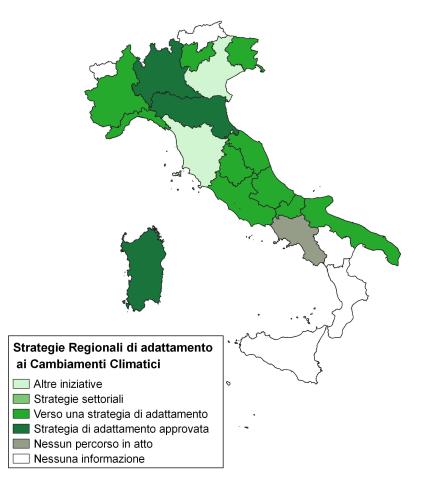Panel 1
FEDERICA ALDIGHIERI with contributions from Francesca Palomba
Regional Climate Change Adaptation Strategies and Plans are the primary tools available to regional authorities to address the impacts of climate change and implement actions aimed at reducing territorial vulnerabilities. In Italy, the number of adopted regional strategies and plans remains very limited. Despite the absence of a binding regulatory framework and a national programmatic reference context, there are ongoing initiatives, projects, and climate vulnerability studies that are expected to lead toward the formal adoption of first Adaptation Strategies and subsequently Climate Change Adaptation Plans. The challenge posed by climate change urgently requires the definition and implementation of concrete actions to enhance territorial resilience.
Climate Change Adaptation Strategies and Plans represent the primary response tools available to regions to address ongoing and projected impacts on their territories. The indicator identifies the number of Italian regions that have initiated processes towards their adaptation strategy and/or plan or have already adopted them. This indicator provides an overview of the status of these planning instruments following the adoption and approval of the National Adaptation Strategy to Climate Change (SNAC, 2015) and in anticipation of the approval of the National Climate Change Adaptation Plan (PNACC).
Identify the number of Italian regions engaged in the preparation/adoption of climate change adaptation planning instruments (Strategies and/or Plans), specifying the phase each region is currently at within the process.
EU Strategy on Adaptation to Climate Change (COM (2013) 216 final)
National Adaptation Strategy to Climate Change (NAS, 2015)
National Adaptation Plan to Climate Change (NAP), currently under approval
In Italy, there is no binding legislation on adaptation to climate change and, therefore, no specific targets or legal obligations for regions to develop adaptation planning instruments. However, in 2015, the National Adaptation Strategy to Climate Change (NAS, 2015) was adopted. This document outlines a national vision and provides a strategic framework for adaptation efforts. The Strategy promotes more effective cooperation among institutional actors at all levels (national, regional, and local) and supports the identification of territorial and sectoral adaptation priorities.
Following the NAS, the Ministry for the Environment and Protection of Land and Sea (now the Ministry of the Environment and Energy Security – MASE) launched the process of drafting the National Adaptation Plan to Climate Change (NAP). The draft was submitted for consultation with regional and local authorities and is currently undergoing the approval process.
Panel 2
The information collection system, based on a voluntary questionnaire sent to the Regions, does not ensure complete response coverage.
Data quality assessment
Regions
The data were collected through a questionnaire prepared by ISPRA technical staff and administered to the regions by the Ministry of the Environment.
Regional 16/20
December 2021.
Indicator assessment
The indicator reports, for both Adaptation Strategies and Plans, the absolute number of regions that have:
– initiatives toward the adoption of Strategies/Plans,
– sectoral initiatives,
– an ongoing process,
– formal approval.
Status of Regional Climate Change Adaptation Strategies and Plans in Italy (as of 2021)
Out of the total 21 Italian regions and autonomous provinces, 16 responded to the voluntary questionnaire prepared by ISPRA and disseminated by the Ministry of Environment and Energy Security (MASE). The Basilicata Region, Autonomous Province of Bolzano, Calabria, Sicily, and Valle d'Aosta did not provide a response.
Among the responding regions, Lombardy is the most advanced in the adaptation process, having formally adopted both a Regional Climate Change Adaptation Strategy (2014) and the related Regional Adaptation Plan (Regional Action Document on Climate Change Adaptation).
Two additional regions — Emilia-Romagna and Sardinia — have also adopted their own Regional Adaptation Strategies.
Ten regions report having initiated a pathway toward the development of a strategy:
-
Abruzzo
-
Friuli Venezia Giulia
-
Autonomous Province of Trento
-
Liguria
-
Marche
-
Molise
-
Piedmont
-
Apulia
-
Umbria
-
Veneto (This figure remains unchanged since 2018.)
A positive signal emerges from the fact that 14 out of 16 responding regions have participated in at least one project focused on climate change adaptation. However, the thematic scope of these projects is limited — primarily addressing agriculture, coastal and marine zones, with only one case focusing on energy.
Among the 13 regions that have not yet adopted a strategy, 9 have conducted climate analyses on past trends and future projections. Of these:
-
7 have carried out vulnerability assessments related to climate change impacts.
-
4 have also identified specific adaptation actions.
Furthermore, 10 of these 13 regions have already implemented adaptation measures that are not yet formally recognised as part of an official strategy or plan.
The only adopted Adaptation Plan remains that of Lombardy, as in 2018, indicating no growth in the number of approved plans.
In 2021, three Regional Adaptation Strategies were approved (Lombardy, Emilia-Romagna, Sardinia), compared to two in 2018 (Lombardy, Emilia-Romagna).
Additionally, information received by ISPRA in October 2023, outside the 2021 survey, shows that the Aosta Valley also approved its Adaptation Strategy in 2021.
Data
Figure 1: Regional Climate Change Adaptation Strategies (2021)
ISPRA processing based on data provided to MASE by the Regions
According to information received by ISPRA in 2023, after the survey was conducted, the Valle d'Aosta Region also adopted its Regional Climate Change Adaptation Strategy.



The questionnaire responses indicate an increased awareness among regional administrations regarding climate change adaptation policies. Indeed, 14 regions have participated in at least one project on the topic; there is growth in climate and vulnerability studies. However, not all sectors proposed by the National Adaptation Strategy are covered, with greater focus on certain themes such as agriculture, marine and coastal areas, while sectors like health and energy remain underrepresented.
Conversely, there is no clear indication of an awareness of the urgency required to address the impacts of climate change.
Complete information collected through the questionnaires is published on the National Climate Change Adaptation Platform, under the “Nella Tua Zona” section: https://sinacloud.isprambiente.it/portal/apps/webappviewer/index.html?id=3368c206ced14cad8b79b13385391201 .
Consulting this section can be useful for replicating good practices implemented by administrations other than one’s own.